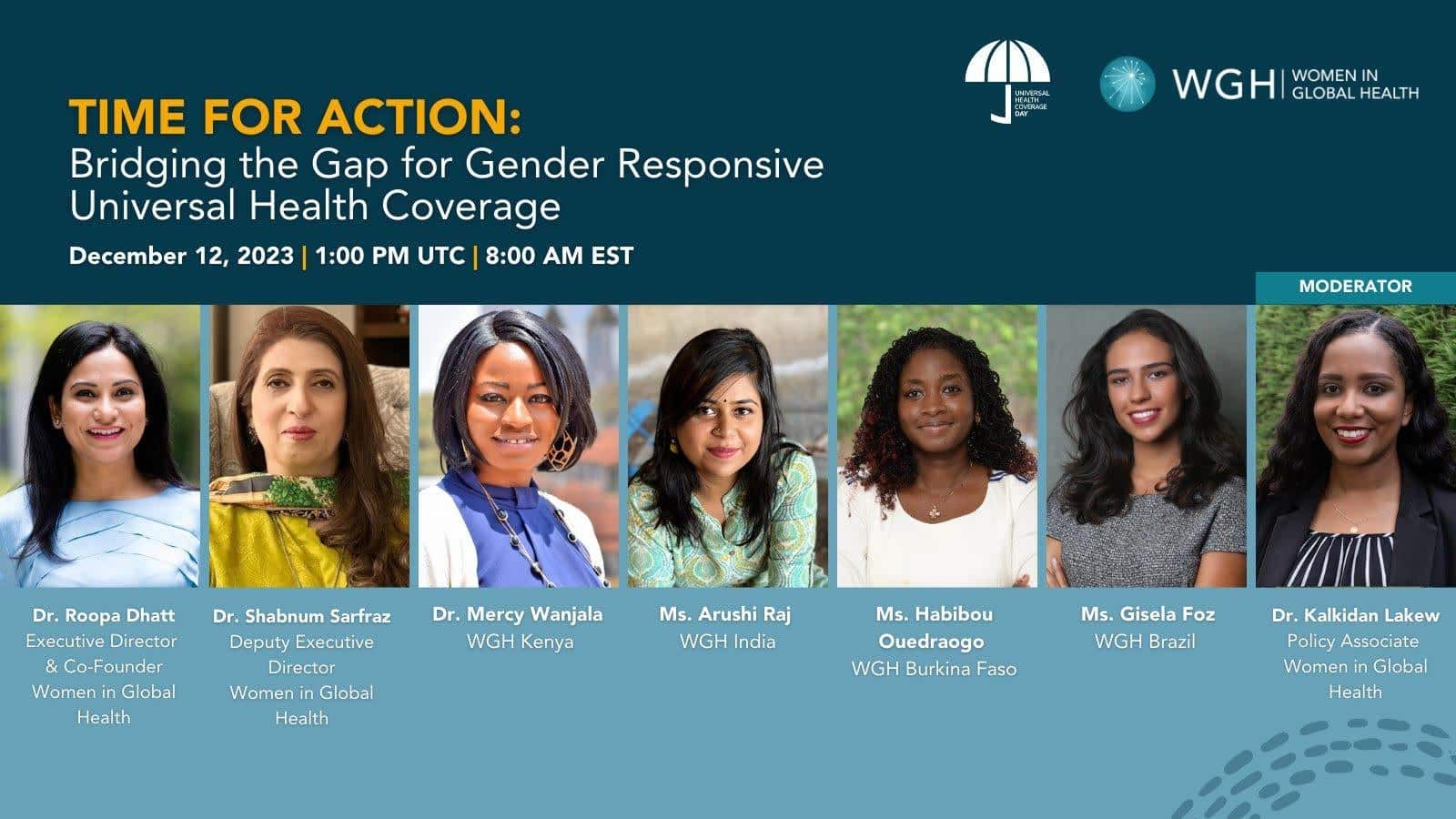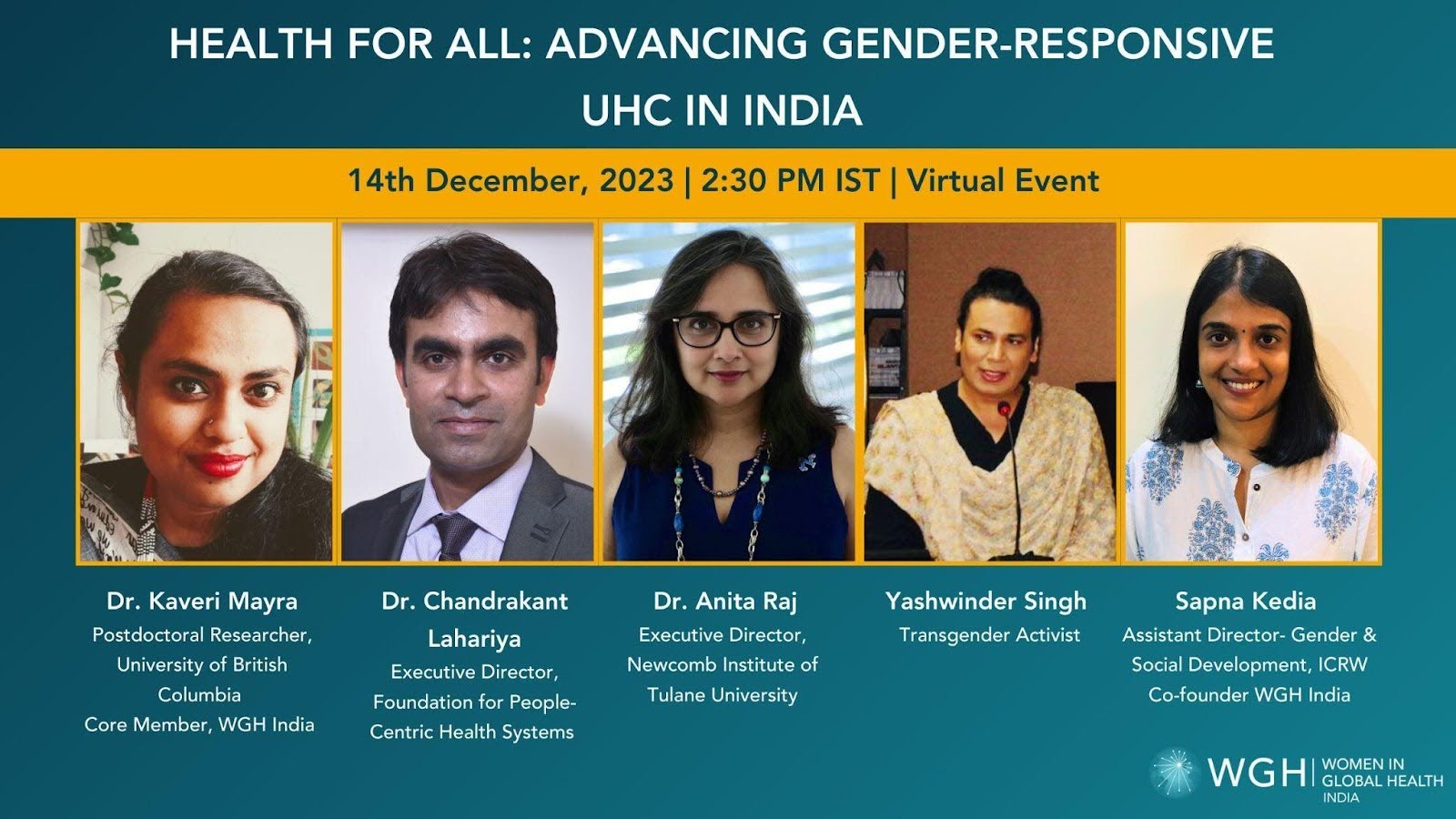Achieving UHC in India: The way forward can only be gender-responsive
12 December 2024
There is no blueprint for UHC that can be applied equally to all country contexts . Although health ministries typically lead on UHC, the definition in the SDGs includes prevention, health promotion and emergency preparedness measures so implementation must include the whole of government. UHC is a political choice and will be dependent on national negotiations on the social, political and commercial determinants of health, and critically, the gender determinants of health.
UHC will not be achieved anywhere without addressing gender equality, women’s rights and the role of women in the health workforce.
WGH India, an advocate for women health workers
Since 2019, the WGH India Chapter has been actively working on key issues related to women in health and women’s health. WGH India seeks to amplify the experiences and knowledge of women working in the health sector, particularly frontline workers, and marginalized vulnerable groups, through dialogues, research, and advocacy efforts. The Chapter is growing a movement to demand the advancement of women’s leadership in the health sector in India. Currently, WGH India comprises more than 180 members, which include nurses, midwives, doctors, public health professionals, health policymakers, researchers, and private-sector health workers. Since January 2022, WGH India has been hosted at SAATHII (Solidarity and Action Against The HIV Infection in India), New Delhi.
Quick Facts: India
India is the most populous country in the world, with a population of 1.4 billion and a population growth rate of 0.68%. [1] For every 100 girl babies born, 108 boys are born, indicating the presence of femicide. [2] The median age of the population is 28 and the average life expectancy is 67 years. Ten percent of the population lives on $2 a day. [3] Sixty-five percent of the country’s population lives in rural areas. [4]
Progress has been made in some health areas: almost 90% of births are now attended by skilled attendants and the maternal mortality rate has fallen to 97 per 100,000 births. The UHC Service Coverage Index was at 63 out of 100 in 2021. The main cause of death is now from non-communicable diseases. [5]
In relation to gender equality, key indicators to note include:
- Girls’ completion rate for primary education was over 90% in 2016, however, only 40% completed upper secondary. [6]
- Women’s participation in the workforce is 23%. [7]
- Only 15% of national parliament seats are held by women. [8]
In the health sector, women average around 28% in leadership roles across national health organizations, with the exception of the Nursing Council which has a majority female membership and 75% of women in leadership roles. However, averages can be misleading and some organizations such as the Pharmacy Council of India have almost no women in leadership positions.
India is committed to achieving Universal Health care for all by 2030. To achieve this goal, improving the health of women and girls is critical. Health equity is intrinsically linked to gender equality.
Women and girls in India lack access to essential health services. They have specific health needs that often go unaddressed. Failure of national health policies to properly reflect the interests and needs of women and girls prevents the securing of UHC in India. UHC discussions risk forgetting that gender equality and women’s rights drive health for all.
WGH India’s effort to promoting gender-responsive UHC
Engaging with G20
- WGH India made their voice heard at the G20 event, hosted by India. At the national level, the WGH India team participated in four G20/C20 events in Pune, Nagpur, Faridabad, and Bhubaneswar, advocating for women’s leadership in healthcare and highlighting the challenges faced by Community Health Workers in India.
- Working with the G20/C20 Gender Equality and Disability Working Group WGH India gave a keynote address during C20 GED Working Group Meeting on Role of Women in Community Health and Development, in Pune. WGH India members actively participated in the GED Working Group Summit, held in April in Bhubaneswar.
- WGH India’s presence was also seen in the W20 event held in February in Aurangabad
Membership engagement resulting in collaborative efforts:
- Diverse women leaders and advocates from the WGH India community collaborated and submitted recommendations on the draft Menstrual Health and Hygiene Policy formulated by the Ministry of Health and Family Welfare, India in October 2023.
- Through other collaborative efforts between members WGH India submitted a letter to the Ministry of Women and Child Development, for inclusion of anemia and disability in the National Family Health Survey (NFHS)-6 in August 2023.
76th WHO SEARO Regional Committee Meeting:
 WGH India sent a delegation to the WHO SEARO Regional Committee Meeting. advocating for gender equity in health within the region.
WGH India sent a delegation to the WHO SEARO Regional Committee Meeting. advocating for gender equity in health within the region.
During the meeting, WGH India Chapter issued two statements, both written and oral, on integrating Sexual and Reproductive Health and Rights (SRHR) interventions into Universal Health Coverage (UHC) strategies and prioritizing the welfare of women health workers and enhancing their capacities to effectively deliver UHC.[ Written Statement | Oral Statement ]
Participation in the Gender & UHC Webinar organized by WGH on 12th December, “Time for Action: Bridging the Gap for Gender-Responsive Universal Health Coverage” on UHC day.
During the discussion, WGH India’s Arushi Raj, articulated challenges and strategies for establishing gender-responsive Universal Health Coverage from an Indian perspective.

Gender & UHC Coalition:
- WGH India has been building on the idea of creating a short-term coalition with organizations working on Gender and UHC in India and eventually developing a community of practice around it. Currently, they are working on identifying key priorities and have initiated conversations on potential collaboration with Gender Collab (led by Oxford Policy Management & QuickSand).
Members’ Consultation to co-develop WGH India Strategy Document, October 2023:
- 18 members joined the consultation to begin working on a Strategy document for WGH India, which will lay out the key priority areas for WGH India to work within research, advocacy, social media engagement, grant writing and partnership building space, with an emphasis on UHC and gender equity as our current area of work.
Webinar on Health for All:
- Advancing Gender-Responsive Universal Health Coverage (UHC) in India, a webinar on December 14th, bringing together a rich and diverse panel to identify key priorities and strategies for developing Gender-Responsive UHC in India.

76th World Health Assembly (WHA), Geneva, May 2023
- WGH India was part of the WGH Delegation and participated in the panel discussions and bilateral meetings with various countries to advocate and support for incorporating gender responsive language in national policies, guidelines, and other relevant documents.
- WGH India joined a distinguished panel on SRHR as a vital component of Universal Health Coverage. These discussions were critical to informing the ground realities for the framing of UHC Political Declaration.
78th United Nations General Assembly- High-Level Meeting (UNGA-HLM), New York September 2023
- WGH India as part of WGH delegation participated in level health-related meetings, engaged in various bilateral meetings with member state delegations and spoke in several plenary sessions, including a crucial discussion hosted by Alliance for Gender Equality and UHC.
Conclusion
For universal health coverage, “leave no one behind” means that countries should prepare equitable and gender-responsive health systems that consider the interaction of gender with wider dimensions of inequality, such as wealth, ethnicity, education, geographic location and sociocultural factors and implement them within a human rights framework.
With 51 gender-specific indicators across the 17 UN Sustainable Development Goals (SDGs), the link between health and gender cannot be understated. As evident in SDG 5(on gender equality), Target 5.5 emphasizes women’s participation and equal leadership opportunities, recognizing their impact on health outcomes. Target 5.6 aims for universal access to sexual and reproductive health, acknowledging the essential connection between gender equity and sustainable development. The SDG targets and indicators directly or indirectly address health inequalities, illustrating how gender equality is crucial for a strengthened health system.
Gender equality isn’t just a goal; it’s a key driver of progress in creating gender responsive health systems, ultimately achieving UHC.
References
[1] United Nations, Department of Economic and Social Affairs, Population Division. World Population Prospects 2022.[Internet]. United Nations; 2022
[2] Ibid
[3] World Bank. Poverty and Inequality Platform[Internet]. World Bank; 2022. Available at: https://pip.worldbank.org/home
[4] Ibid
[5] World Health Organization. Global Health Estimates 2020: Deaths by Cause, Age, Sex, by Country and by Region, 2000-2019. Geneva, World Health Organization; 2020. Available from https://www.who.int/data/gho/data/themes/mortality-and-global-health-estimates/ghe-leading-causes-of-death
[6] UNICEF, State of the World’s Children 2023. Data set; 2023 Available at https://data.unicef.org/resources/sowc-2023/
[7] International Labour Organization. ILO Stats: Statistics on Women. International Labour Organization; 2023. Available at:https://ilostat.ilo.org/topics/women/
[8] OECD. Social Institutions & Gender Index. OECD Development Centre; 2023. Available at https://www.oecd.org/stories/gender/social-norms-and-gender-discrimination/sigi?country=IND
